Polyphemus Silkmoth, Antheraea polyphemus (original) (raw)
Polyphemus Silkmoth
Antheraea polyphemus
This process started a little differently than the Bombyx mori and Samia ricini. Instead of ordering eggs by mail, I started with live cocoons. Polyphemus moths are a wild North American species, Antheraea polyphemus, closely related to the Chinese Oak Silkmoth or Tussah moth, Antheraea pernyi and the Indian Tasar moth, Antheraea mylitta. To see the silk spun from this species, click here.

These are the cocoons. I started with nine of them. I found another one locally here in the Dallas area, on an oak tree at a park. Note: park rangers don't appreciate people walking around with tree loppers. He didn't say anything, but I got That Look.
This evening when I got home from work, this lovely lady was hanging on the screen, drying her wings. You can't really see in this shot, how soft her wings are. The back of the wings look like dead leaves; this is a camouflage to help the moths hide. April 6, 2004.
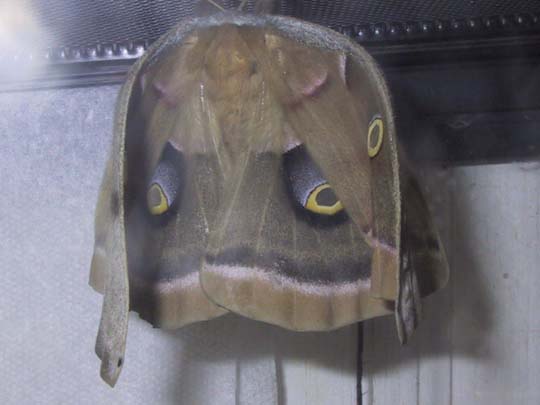
But in this one, you can see how floppy the wings are! She flapped her wings back and forth, pumping them up. The top of her wings are beautiful; you can't really see it, but the little spots inside the eyes are reflective like hematite.
This is the terrarium the cocoons are in, outside. In order to ensure that they hatch out in the right season so that there will be other moths around (we'll get to that in a little bit...) they have to be exposed to local temperatures, and even the occasional bit of rain, as long as they don't get drenched. The paper towel across the back of the glass is for the moths to climb up on; once they hatch out of the cocoons, they need to hang to let their wings fill out.
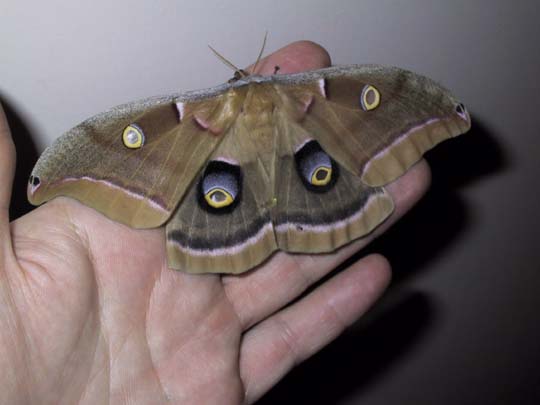
This is what she looks like after drying for a while. I think these moths are amazing looking. They are called Polyphemus moths after a monstrous Greek giant with huge eyes. These eyespots are believed to startle predators; the moth displays them when disturbed.
These are the two ways you can tell she's a female: First, the thin antennae; the male would have big bushy ones. Second, the large distended belly. It's full of eggs. And also full of liquid which the moth will squirt on you if surprised. Be warned. April 6, 2004.

April 9, 2004. This male hatched out of its cocoon today. Another female hatched as well. Last night, the first female managed to attract the attention of a local male; unfortunately, he didn't manage to do his mothly duty by her, and so there are no photos of the mating or the eggs. Hopefully the new female will be able to attract a local mate tonight, and will get one who knows his business! I would love to get a pairing between these two beautiful moths, but I don't know if they're related (these were wild-collected cocoons), and they typically refuse to mate with siblings. This male is a little more colorful than the female; the cinnamon and pink colors are very pretty. This posture is some kind of "play dead, look tough" act - the moth will do this whenever disturbed. Its big scary eyes are supposed to frighten away predators. It will flop around on the ground rather than climb or fly when startled. Wingspan is six inches tip to tip.
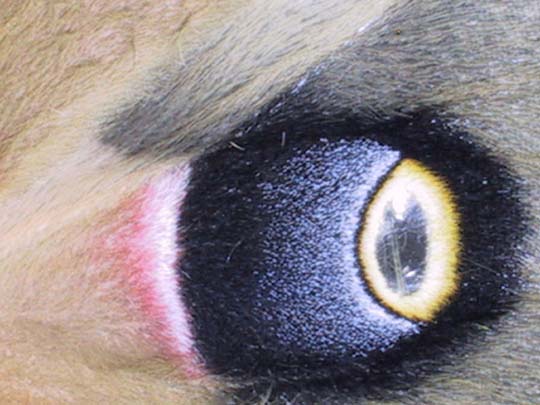
These moths are amazingly hairy; the texture looks really like fur. You can see the transparent eye-spot center, and the scales that give the moth its color.
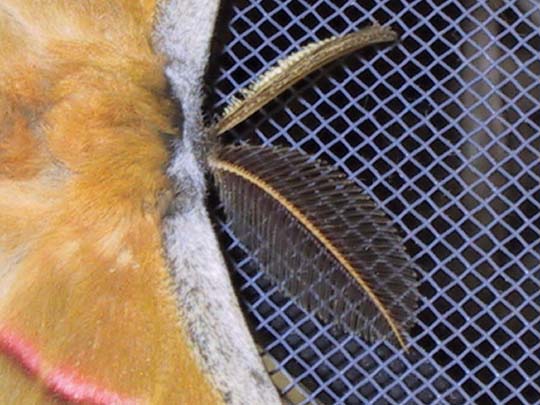
A closeup of the male's antennae. He uses these to detect the pheremones released by the female; a male can scent a female from miles away. The male who flew in last night had antennae so long he was literally tripping over them as he walked across the top of the cage.
Note: the following four photos are from a different batch of moths, but are included to show the mating process.

This is the small tent that I use to hang the calling female out in a front-yard tree. I learned that it is very important to get them high up enough to avoid being caught by the cats! When the males fly in, I catch them and toss them in the cage; I figure that competition is likely to result in the best mating. Also, sometimes the males are not able to breed, and I want to hedge my bets. August 30, 2004.

The wild moths have a beautiful range of colors. This handsome cinnamon fellow didn't end up winning in the mating game, but I wish he had! I was handling the moths outside in the near-dark at first, so I couldn't see all the colors, etc. I brought the whole tent full of moths inside to sort out and photograph.
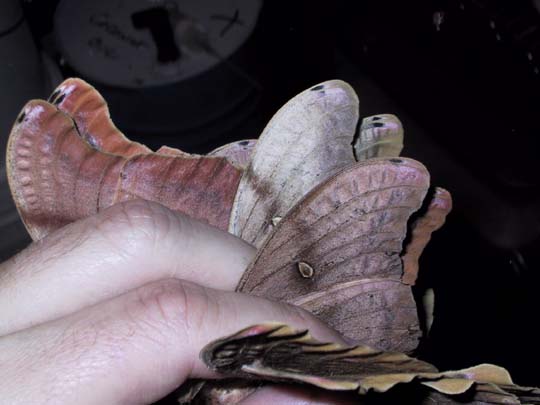
These are the spare males, about to be taken back outside and released to find another female. Note the variety of colors! Some are very pink, others chocolate brown, some nearly gray, and of course the bright cinnamon. This was the best night of moth-calling I've had yet - six healthy males showed up to find the one calling female.

After all the extra males are pulled out, I can see that the female is properly paired up. I made sure of this before releasing the males. After mating for a day, the moths separate. The male is released outside, and the female is placed inside a brown paper lunch bag to lay her eggs.
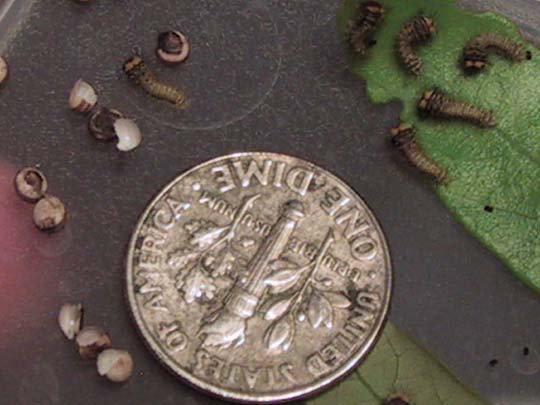
Now, back to the April brood. I acquired some fertile eggs, which began to hatch on April 29th. It usually takes about 14 days for the eggs to incubate, depending somewhat on temperature.
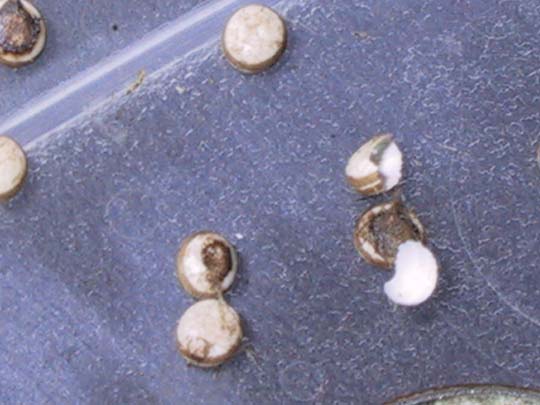
Polyphemus caterpillars eat part or most of their eggshells before wandering off in search of food. The eggs are substantial in size - larger even than the cecropia eggs.

The hatchlings are very top-heavy; their heads seem big in proportion to their bodies. The younger instars, like those of many of the Saturniids, are gregarious, preferring to eat in groups; they will tend to be more separate as they grow older. April 29, 2004.
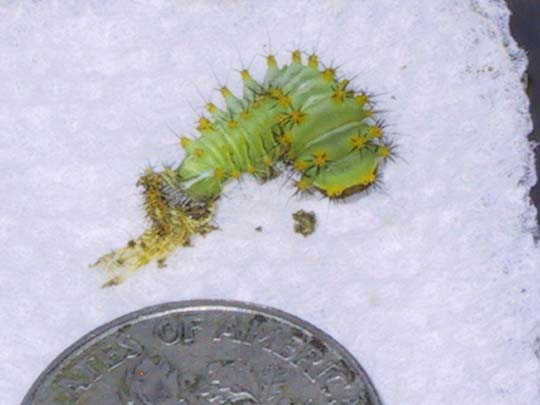
May 4, 2004. The caterpillars have begun changing to the second instar.

The coloration is essentially still the same, although they are a little more evenly green. May 4, 2004.
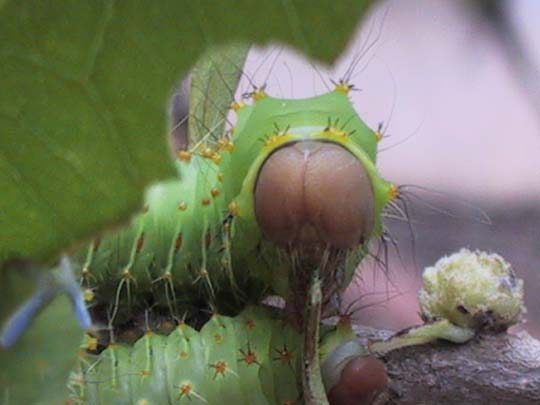
This is a third-instar caterpillar. The hairs show up particularly clearly in this shot. May 16, 2004.
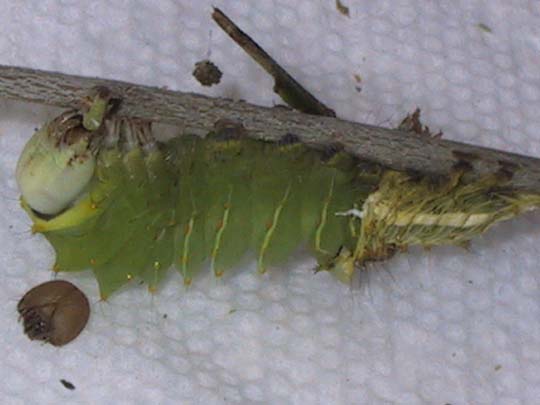
This caterpillar has just shed his third skin, and is wearing its new fourth-instar suit. Note the white face; it will darken within a couple of hours, becoming the same brown-leaf shade as the previous one, which is lying discarded beside the caterpillar to the left. They pop off like plastic masks, and are hollow once discarded. May 19, 2004.

This is an illustration of the different sizes of heads; the four instars are ranged left-to-right. The fifth instar head won't be discarded in a skin-change; it will remain in the cocoon with the developing moth. When the caterpillar changes to a pupa, it doesn't cast off its head and slip out of its skin, the skin splits down the back instead, and the face remains in one piece with the rest.

May 22, 2004. The position of this dime just came out this way - I think it makes the worm look like an icon of a saint. Saint Poly Phemus.

The bases of the hairs, called scoli, are a brilliant, reflective silver - they're very pretty. The caterpillar has a translucent jade color that is hard to reproduce. This is a fifth-instar caterpillar. May 22, 2004.
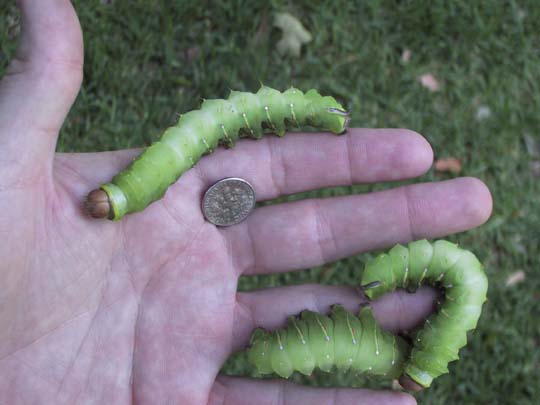
June 5, 2004. The caterpillars are really getting huge. You can see the growth, by comparing the head to the previous image - the caterpillar hasn't changed faces, but the face plate looks tiny in proportion to the rest of its body now.

The fifth-instar head is massive, and allows the caterpillar to eat at an appalling rate. Note the large mandibles.

The silver-spotted scoli are still magnificent; they stand out really well as the worms grow larger. June 5, 2004.
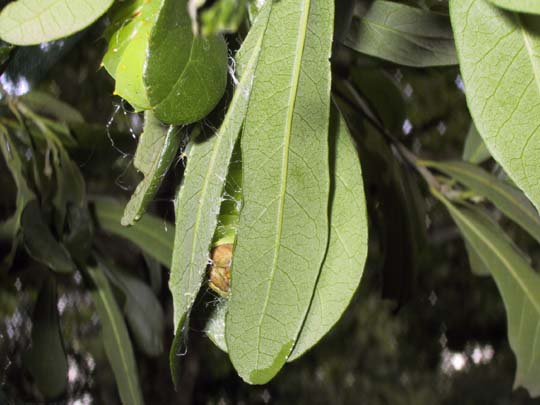
Beginning a few days ago, the caterpillars started spinning. This is the first time I've managed to catch one in the act - they seem to like to spin up at night, when I'm not watching. The cocoon is started by sketching silk onto several leaves, which are pulled into a little cluster; the caterpillar then works dilligently to make a solid cocoon inside the leaves. June 6, 2004.

These are the cocoons, with the leaves stripped off of them. They are much whiter than the wild cocoons I started with; I don't know if it's from sun exposure, or from the type of oak they ate. Mine were fed on live oak, Quercus ilex. They may darken as they age. June 6, 2004.
If the cocoons are spun early enough in the summer, the moths will hatch out in about two weeks. If they are spun closer to winter, they will go into diapause, a period of rest much like hibernation, and emerge in the spring. Here in Texas, I'm expecting to see at least a second, if not a third, flight.
